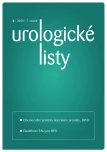STAGING AND GRADING OF PATIENTS WITH LOWER URINARY TRACT SYMPTOMS (LUTS): A PATHOPHYSIOLOGICAL CLASSIFICATION FOR FURTHER MANAGEMENT
Authors:
K. T. Foo
Authors‘ workplace:
Department of Urology, Singapore General Hospital, National University of Singapore
Published in:
Urol List 2009; 7(3): 36-38
Overview
BPH is a heterogeneous disease. Using non invasive transabdominal ultrasound, it can be graded according to the prostate volume (PV) and configuration: Intravesical prostatic protrusion (IPP) to predict obstruction. The severity of the disease can be staged according to the presence or absence of significant obstruction and bothersome symptoms. Stage one would be patient with no significant obstruction and no bothersome symptoms, and stage II would be patients with bothersome symptoms but no significant obstruction. Stage III patients are those with significant obstruction, irrespective of symptoms. Stage IV would be patients with complications of BPH. Low grade, low stage patients can generally be watched, high grade high stage patients would need more invasive treatment such as surgical removal of the adenoma.
Stage II patients with low grade IPP can be managed with alpha blockers, while those with high grade IPP and large prostate > 40 grams would benefit from 5 alpha reductase inhibitors. This pathophysiological classification with grade (pathology) and stage (physiology), using non invasive parameters, can be used to compare results of treatment across institutions and also would improve the cost effective management of this common disease BPH.
Key words:
benign prostatic hyperplasia, grading and staging
Sources
1. Foo KT. Current assessment and proposed staging of patients with benign prostatic hyperplasia. Ann Acad Med Singapore 1995; 24: 648–651.
2. Garraway WM, Armstrong C, Achid S, King D, Simpson RJ. Follow-up of a cohort of men with untreated benign prostatic hyperplasia. Euro Urol 1993; 24: 313–318.
3. Flanigan RC, Reda DJ, Wasson JH, Anderson RJ, Abdellatif M, Bruskewitz RC. 5 year outcome of surgical resection and watchful waiting for men with moderate symptomatic benign prostatic hyperplasia: a department of veterans affairs co-operative study. J Urol 1998; 160: 12–16.
4. Randall A. Surgical pathology of prostatic obstruction. Baltimore, Md: Williams & Wilkins 1931.
5. Chia SJ, Heng CT, Chan SP, Foo KT. Correlation of intravesical prostatic protrusion with bladder outlet obstruction. BJU Int 2003; 91(4): 371–374.
6. Jacobsen SJ, Jacobson DJ, Girman CJ et al. Natural history of prostatitism: risk factors for acute urinary retention. J Urol 1997; 158: 481–487.
7. Poulsen AL, Schou J, Puggaard L, Nordling J. Prostatic enlargement, symptomatology and pressure/ flow evaluation: interrelations in patients with symptomatic BPH. Scad J Urol Nephrol Suppl. 1994; 157: 67–73.
8. Kuo HC. Clinical prostate score for diagnosis of bladder outlet obstruction by prostate measurements and uroflowmetry. Urology 1999; 54(1): 90–96.
9. Rosier PF, de Wildt MJ, Wijkstra H, Debruyne FF, de l Rosette JJ. Clinical diagnosis of bladder outlet obstruction in patients with benign prostatic enlargement and lower urinary tract symptoms: development and urodynamic validation of a clinical prostate score for the objective diagnosis of bladder outlet obstruction. J Urol 1996; 155(5): 1649–1654.
10. McConnell JD et al. The long-term effect of doxazosin, finasteride, and combination therapy on the clinical progression of benign prostatic hyperplasia. N Eng J Med 2003; 349 (25); 2387–2398.
11. Hald T. Urodynamics in benign prostaic hyperplasia. A Survey. Prostate Suppl 1989; 2: 69–77.
12. Chia SJ, Foo KT. Is staging of BPH feasible? Ann Acad Med Singapore 1999; 28(6): 800–804.
Labels
Paediatric urologist UrologyArticle was published in
Urological Journal

2009 Issue 3
Most read in this issue
- THE HOLMIUM LASER IN THE TREATMENT OF BENIGN PROSTATIC ENLARGEMENT
- GREENLIGHT PVP. MAYO CLINIC APPROACH, SURGICAL TECHNIQUE, AND OUTCOMES
- Therapeutic Options for Advanced Prostate Cancer. Management of locally advanced and androgen dependent prostate cancer
- Role of radical prostatectomy in the treatment of prostate cancer confined to prostate gland. Reality and myth, truth and fiction about robotic assisted radical prostatectomy
